火星 月惑星研究会 関西支部

Mars Image 2005/11/06(UT)
永長英夫
Ki hyun Nam,Christopher Go,Martin Mobberley,Dr.Timothy J.Parker,Christophe Pellier,Damian Peach,Paulo Casquinha,Marc Delcroix
H.Einaga,K.hyunNam,Christopher Go,M.Mobberley,Tim Parker,Christophe.P,D.Peach,P.Casquinha,M.Delcroix
解説(安達)
ヘラス(Hellas;290W,-50)の北部が明るい。ヘレスポント
ス(Hellspontus;330W,-45)の北部からノアキス(Noachis;0W,-40)方面に明るい
バンドができているが、10月にでたダストストームの名残りのようだ。永長
氏とGoのカラー画像では朝霧の様子が良く分かる。赤道付近の霧が、時間と共
に淡くなる様子が記録されている。また、南半球一帯が黄色いダストに覆われ
ている様子が、良く分かる。Pellierの画像ではニクス・オリンピカ(Nix
Olympica;125W,+20)が明るく写っている。肉眼ではこのように明るく見えない。
アルシア・シルバ(Arsia Silva;125W,-5)の山にかかる雲がはっきりと見える。
(reported by 8 observers)
The northern part of Hellas (290W,-50) is bright. Dust storm great
remains in October though a bright band is made from the northern part
of Hellspontus (330W,-45) to the Noachis (0W,-40) district. The
appearance of the morning mist is understood well in the color image
of Einaga and Go. The appearance where the fog in low latitudes becomes
light at time is recorded. Moreover,the appearance covered with dust
with a yellow southern hemisphere region is understood well. Nix
Olympica (125W,+20) is well informed and it is reflected in the image
of Pellier. It doesn't look bright like this with the unassisted eye.
The cloud that hangs to the mountain of Arsia Silva (125W,-5) is
clearly seen.(reported by 8 observers)
FROM Makoto ADACHI
-------------------------------------------------------------------------------------
|
Hideo Einaga (250mm Newton,Toucam Pro Webcam)
|
 [Hideo Einaga Kasai-City Hyogo-Prefecture Japan]
≪兵庫県 加西 永長英夫≫
[Hideo Einaga Kasai-City Hyogo-Prefecture Japan]
≪兵庫県 加西 永長英夫≫
|
Ki hyun Nam (C8 200mm SCT : ToUcam ProII)
|
Ki hyun Nam (C8 200mm SCT : ToUCam Pro II)
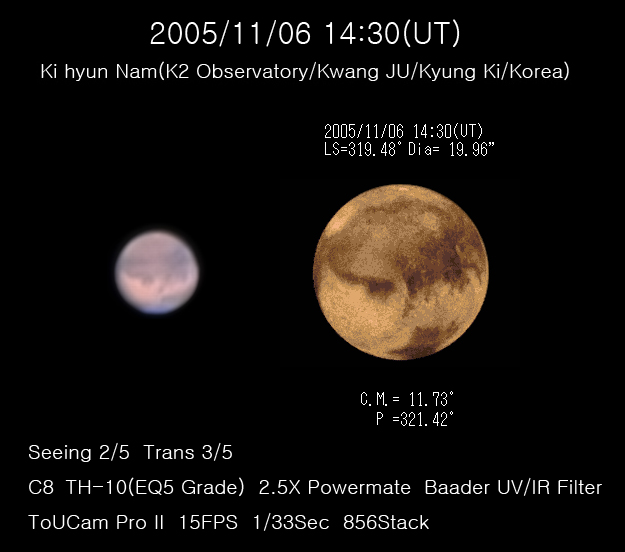 [Ki hyun Nam,Kyungki,Korea]
[Ki hyun Nam,Kyungki,Korea]
|
Christopher Go (Celestron C11,DMK21BF04 monochrome camera)
|

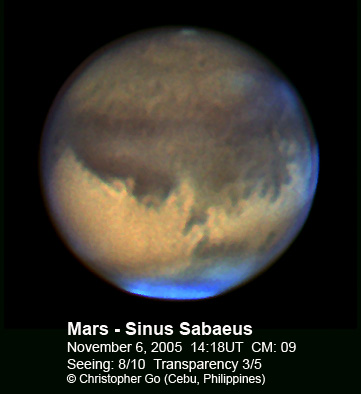
[Christopher Go : Cebu Philippines]
|
Martin Mobberley (245mm Newton: Lumenera LU 075M)
|
A set of Mars images taken last night from Suffolk,UK,is
attached,with Mars at opposition.
Olympus Mons is on the Meridian and bright.
Although Mars was not moving around much,fine detail was
very soft and blurry and so I'd have to say seeing was poor,despite
Registax being able to magic up some reasonable detail.
245mm f/6.3 Newt + 5x Powermate projected to
~8x = f/50. 0.12 arcsecs/pixel (7.4 micron pixels).
Lumenera LU 075M + Red,Green & Blue filters.
Temp. +7 C *Horrendous* dew. Transparency fair.
Some drifting cloud.
Captured/converted with Streampix.
Processed with Registax 3/Maxim DL/PSPro 8.
Further details on the image.
 [Martin Mobberley: United Kingdom]
[Martin Mobberley: United Kingdom]
|
Dr.Timothy J.Parker(12.5" 310mmSC ToUcam PRO)
|
Attached are my best two images from Saturday night.
Seeing started out poor,but improved substantially to "average" or a little better
toward midnight local time.
planetarily
-Tim.
Dr. Timothy J. Parker
Geologist
Athena Science Team member,Mars Exploration Rover mission
Co-Investigator,Mastcam and MARDI cameras,Mars Science
Laboratory rover mission
Director,JPL Regional Planetary Image Facility
Jet Propulsion Laboratory,California Institute of Technology
Pasadena,CA 91109
 [ Dr.Timothy J.Parker : Pasadena,California U.S.A]
[ Dr.Timothy J.Parker : Pasadena,California U.S.A]
|
Christophe Pellier (C14 ; Lumenera ATK-1HS)
|
First I bring your attention on the nov. 6th RGB image which might prove the existence of a yellow dust haze over the whole preceding (west) hemisphere (it can be difficult to see on a laptop screen). Also the SPR looks yellowish.
Now about Olympus : the Mons is bright in every wavelenght and even in violet and UV. It could therefore be a cloud,until Andrea's idea of frost is right,as frost is also bright in the shorter wavelenghts... The problem of the cloud is that it's not supposed to appear before Ls 340 (more than one month and a half later than now),and the diffusion of dust looks to have minimize white clouds elsewhere on the planet... It must be either cloud or frost,it looks too bright to be the natural albedo of the volcanoe. During the opposition period of 2003,Olympus was light in R and G,but not at all in B.
By the way I've changed again my way of processing color images,by adding more green and blue. My previous colors were not satisfaying (too contrasted with some overexposed areas) due to a too great importance given to red wavelenghts - however the planet looks more orange visually,to me. As time goes by I find that getting a good reproduction of colors and contrasts is by far the most difficult part of processing. Processing details is very quick and easy,but I spend a lot of time with colors.
The UV image is 300 x 2 sec.

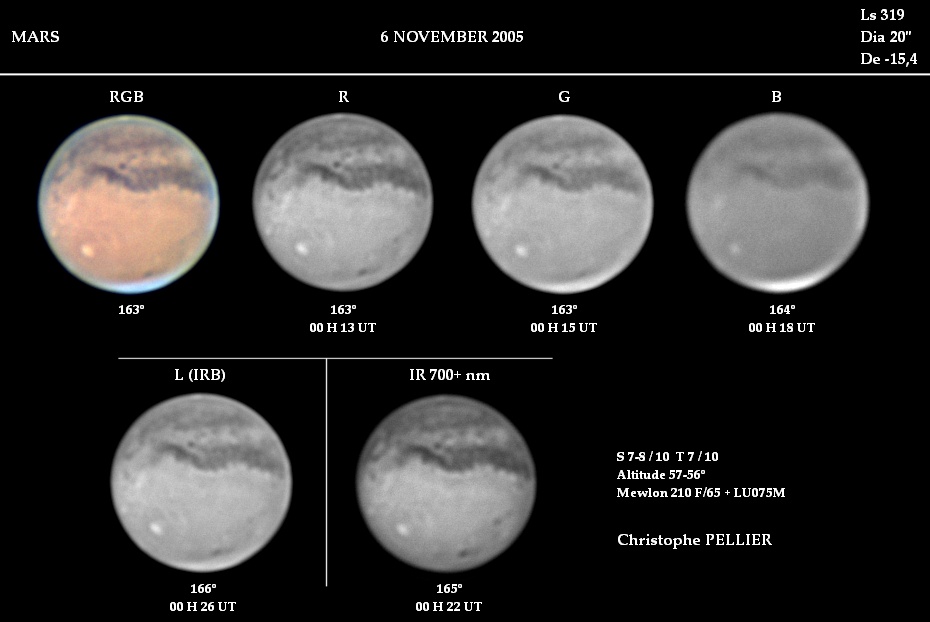
[Christophe Pellier Bruz City,France]
|
Damian Peach (350mm Celestron SCT:Lumenera LU075)
|
Here are some images from November 6th. Fair seeing,but one of my best sessions this season.
Tharsis and Solis Lacus are presented. Olympus Mons is shining brightly in all filters. In the red images it clearly shows a small off-centre bright spot,surrounded by a larger slightly less bright area. Ascraeus Mons is also bright in all filters. Pavonis and Arsia are "lost" in the bright area that seems to cover this part of Tharsis. In Blue this area looks like the Arsia cloud is bright,but with some extensive mistiness across most of Tharsis. Also a faint morning cloud off toward Trivium Charontis on the limb.
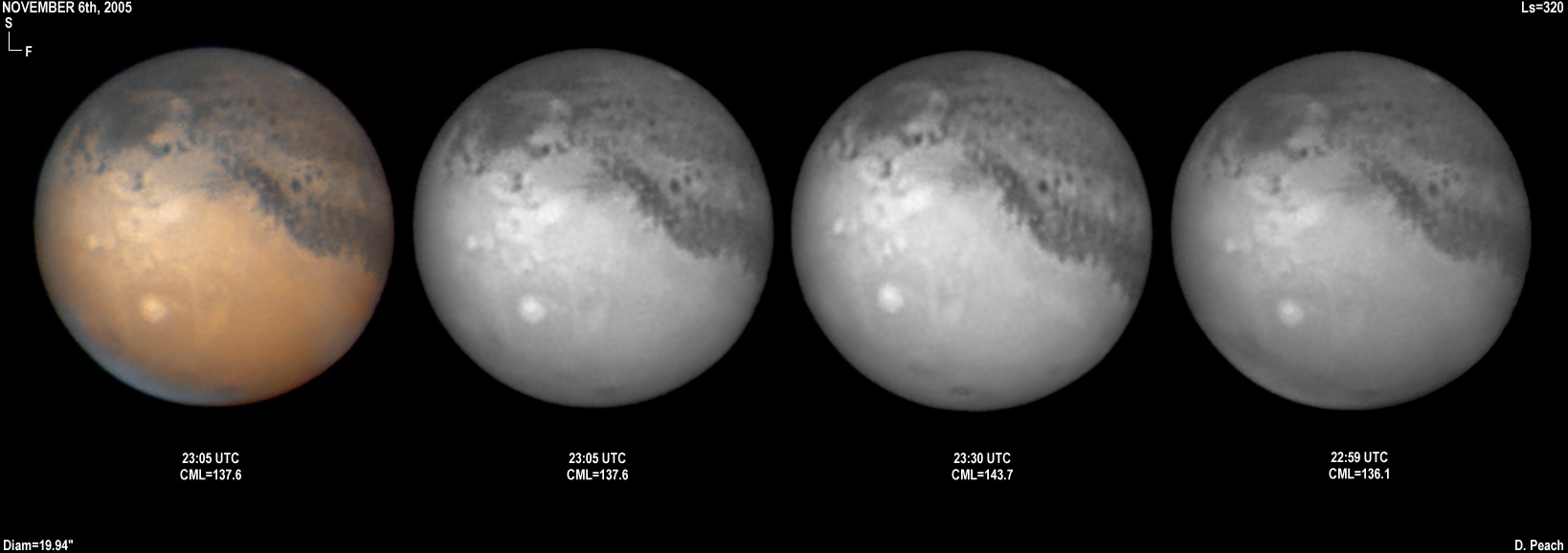
 14" (35cm) Celestron SCT @ f/40.
Lumenera LU075M CCD camera.
Seeing fair (Pickering 4-7.)
Transparency very good (5.5mag.) occ high clouds.
Wind SW (5-10mph.) Heavy dew.
Alt= 54-55 degs.
[Damian Peach: Loudwater,Buckinghamshire,United Kingdom]
14" (35cm) Celestron SCT @ f/40.
Lumenera LU075M CCD camera.
Seeing fair (Pickering 4-7.)
Transparency very good (5.5mag.) occ high clouds.
Wind SW (5-10mph.) Heavy dew.
Alt= 54-55 degs.
[Damian Peach: Loudwater,Buckinghamshire,United Kingdom]
|
Paulo Casquinha (250 mm Newtonian Reflector:Toucam Pro)
|
Mars taken in fair seeing conditions and good transparency,a set of AVI's
from November 7 is now being processed.
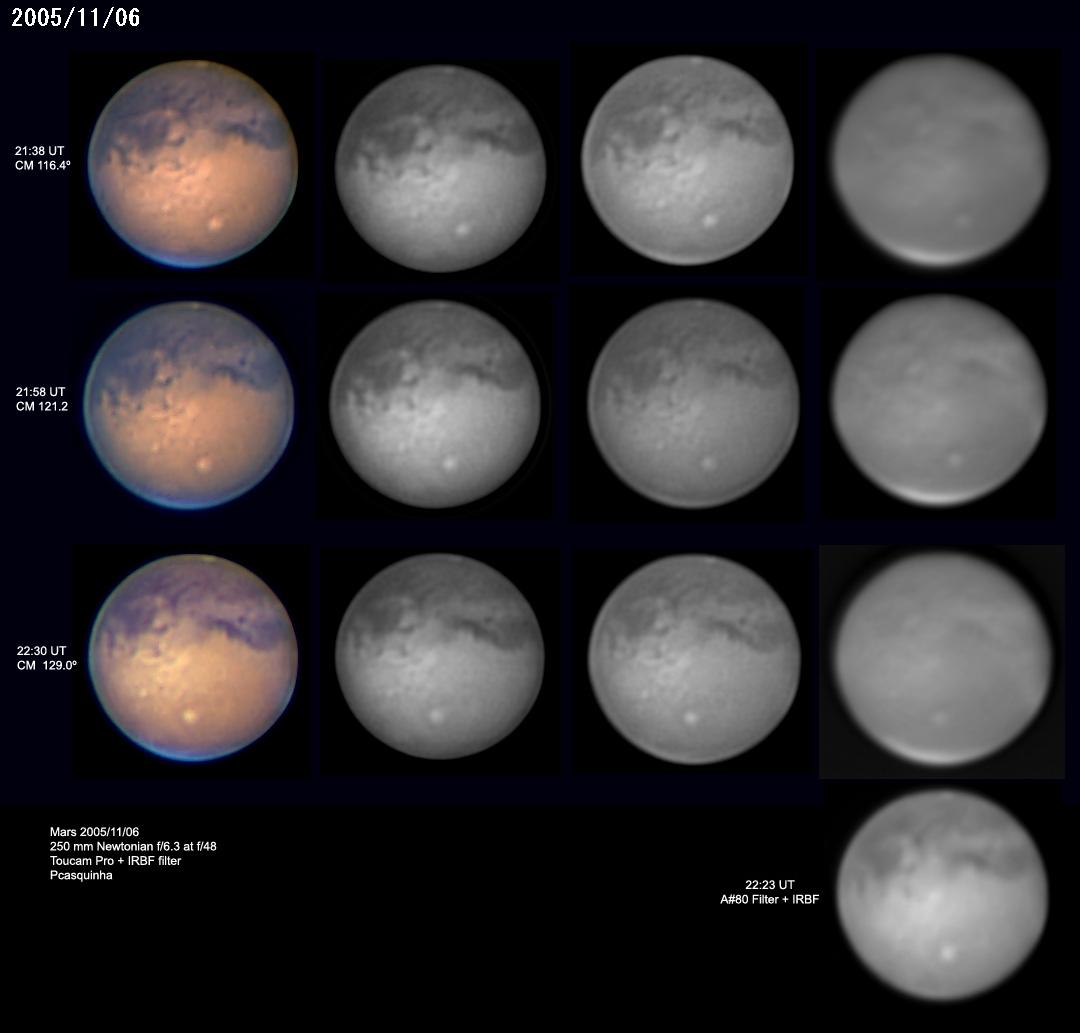 (site: 38.567 N /8.933 W Alt 124 m)
[Paulo Casquinha Palmela,Portugal]
(site: 38.567 N /8.933 W Alt 124 m)
[Paulo Casquinha Palmela,Portugal]
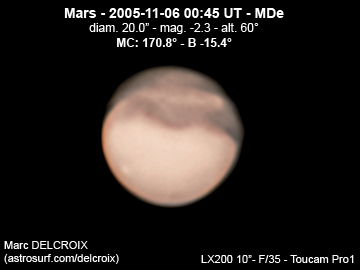
[Marc Delcroix Tournefeuille,France]

 [Hideo Einaga Kasai-City Hyogo-Prefecture Japan]
≪兵庫県 加西 永長英夫≫
[Hideo Einaga Kasai-City Hyogo-Prefecture Japan]
≪兵庫県 加西 永長英夫≫ [Ki hyun Nam,Kyungki,Korea]
[Ki hyun Nam,Kyungki,Korea]

 [Martin Mobberley: United Kingdom]
[Martin Mobberley: United Kingdom] [ Dr.Timothy J.Parker : Pasadena,California U.S.A]
[ Dr.Timothy J.Parker : Pasadena,California U.S.A]


 14" (35cm) Celestron SCT @ f/40.
Lumenera LU075M CCD camera.
Seeing fair (Pickering 4-7.)
Transparency very good (5.5mag.) occ high clouds.
Wind SW (5-10mph.) Heavy dew.
Alt= 54-55 degs.
[Damian Peach: Loudwater,Buckinghamshire,United Kingdom]
14" (35cm) Celestron SCT @ f/40.
Lumenera LU075M CCD camera.
Seeing fair (Pickering 4-7.)
Transparency very good (5.5mag.) occ high clouds.
Wind SW (5-10mph.) Heavy dew.
Alt= 54-55 degs.
[Damian Peach: Loudwater,Buckinghamshire,United Kingdom] (site: 38.567 N /8.933 W Alt 124 m)
[Paulo Casquinha Palmela,Portugal]
(site: 38.567 N /8.933 W Alt 124 m)
[Paulo Casquinha Palmela,Portugal] 
 ALPO-Japan Latest
ALPO-Japan Latest